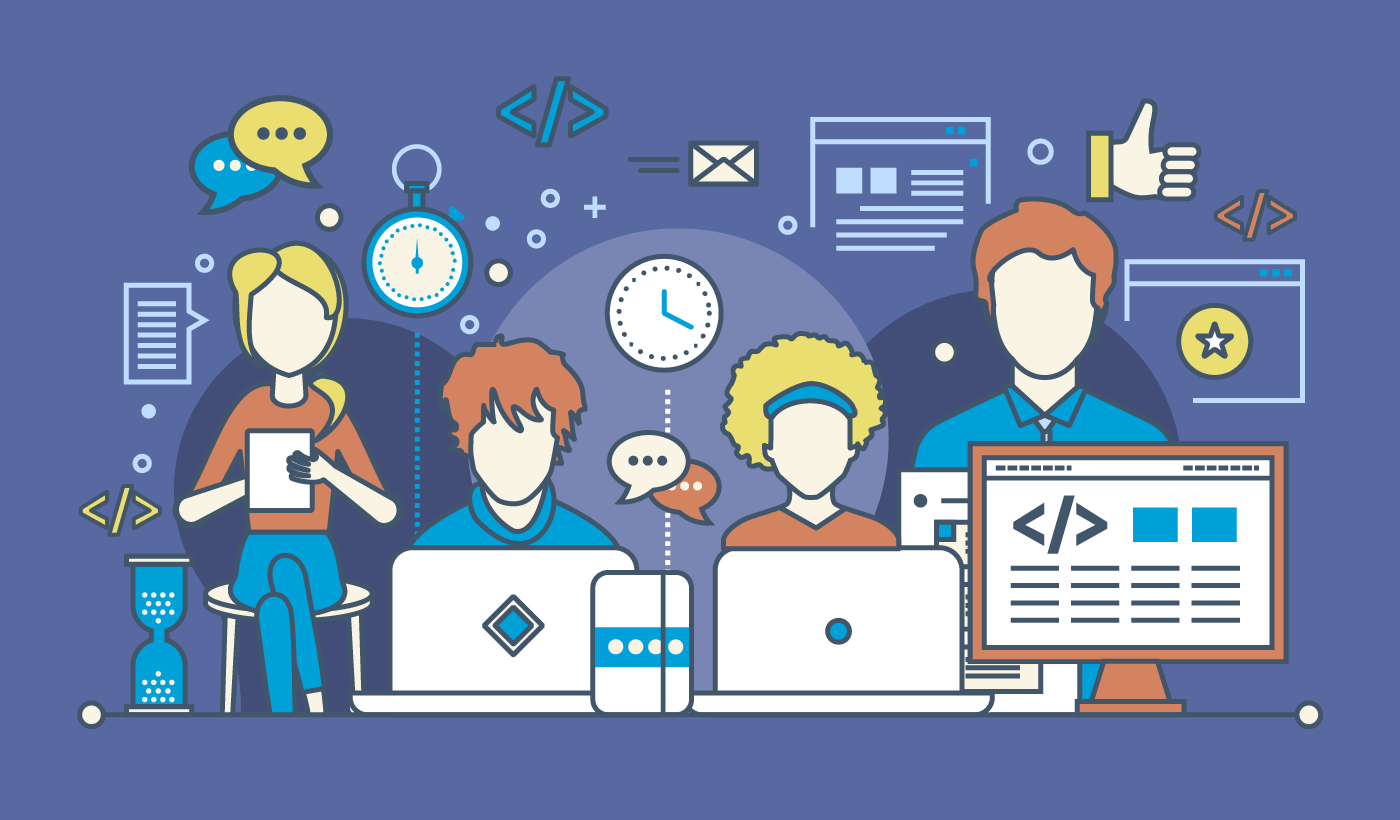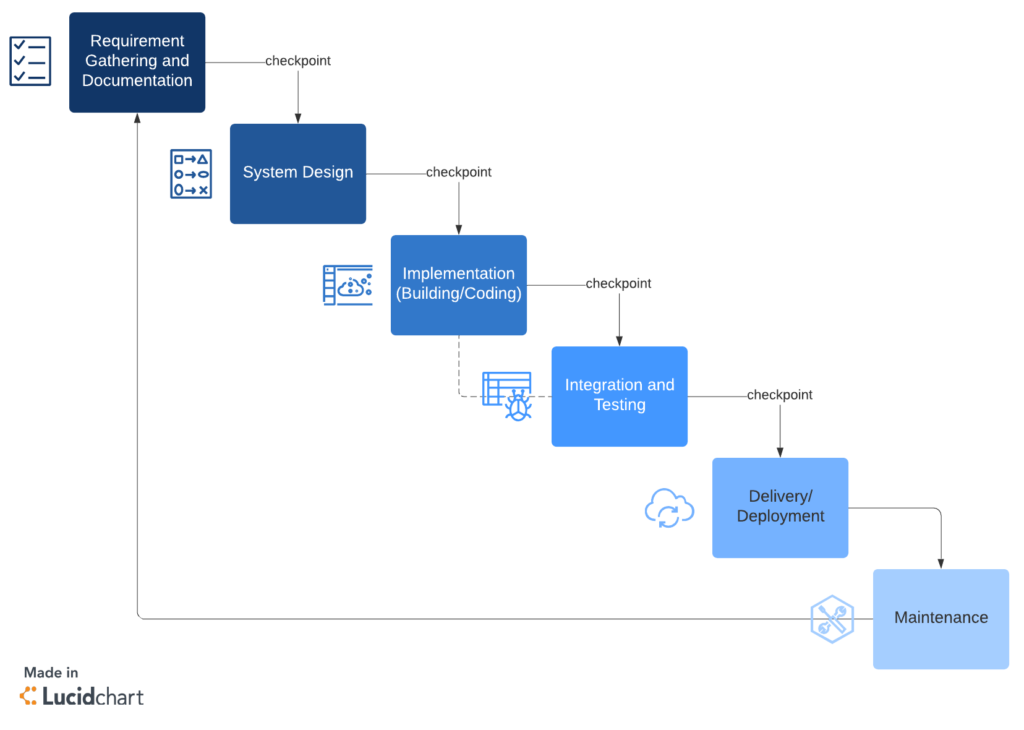So, you are wondering what software development and software development processes are. Well, you are in the right place. In this article, we’ll give you a brief overview of software development; the software development process, and some tips to build a successful software business. Follow our guide, and you’ll see things won’t be too tough.

Understand Software Development
When it comes to software development, there are some essential concepts you need to keep in mind.
1. What is software?
First thing first, it’s necessary to find out the answer to “what is software”. We, however, won’t give you our definition because there is no answer that could rival the one from Wikipedia: “Computer software, or simply software, is a collection of data or computer instructions that tell the computer how to work.” Concise – Unders

In addition, there are 3 main kinds of software:
- System software. This one performs multiple vital functions on your computer, for example, operation software (iOS, Android, Windows, etc.), utilities (Anti-virus, Clipboard managers, Diagnostic programs, etc.), and hardware management.
- Application software. These are the ones we must be really familiar with. We use it to carry out certain activities such as listening to a song, watching videos, sharing photos, etc. Nowadays, application software, or shortly, apps are taking the world by storm and generating huge amounts of revenue for app publishers.
- Malicious software (or malware). The name has shown it all, the very kind of software is able to harm or damage your devices. Its purposes might be just to prank, or worse, to steal your information, scam, etc. Viruses, Worms, Trojans, Ransomware, Fileless Malware, Malvertising, Spyware, etc. are several common types of malware.
And in this blog post, we’ll focus on the development of the second type which is application software. Because I believe that’s what you’re longing for, right?
Recommended reading: Top 10+ Best Software Outsourcing Companies
2. What is software development?
In plain words, software development involves all the tasks that bring a software project from conception to production delivery. IBM Research clarified this definition: “Software development refers to a set of computer science activities dedicated to the process of creating, designing, deploying, and supporting software.”

Software development is often conducted by software developers, software engineers, and programmers. These roles can overlap, and the dynamics between them can vary across development departments and communities.
There are three basic types of software:
- System software: Offer core functions like operating systems, disk management, utilities, etc.
- Programming software: Give programmers tools such as text editors, compilers, linkers, debuggers, and other tools to create codes.
- Application software (apps): Help users perform specific tasks, for example, media players, security programs, data management software, etc.
However, there’s another meaning regarding software development. Oftentimes, this term may refer to the task of writing, fixing, and maintaining the source code of the software.
In addition, another thing that should be introduced to businesses is the two ways of developing options:
- Custom software: A software outsourcing development company will build the software from scratch according to their client’s requirements. As you might know, it’s completely customized and the price will vary as per functions and features needed.
- COTS (Commercial off the shelf): in contrast, this is considered a more economical and time-saving method to develop software. The outsourcing company will provide a product that has the same set of functions, and features based on its best practices to all clients. This service will include very little to no customization so high chances are that the product may not fit your needs.
These are 2 most common options, nevertheless, most of the time, outsourcing development companies such as Designveloper or our pal – ScienceSoft – only provide custom software development service and tailor the software as to how clients need. And here’s a list in case you want to do more research about software development companies.
3. The importance of software development in today’s world
The importance of software development in today’s world is undeniable. With IT spending on enterprise software reaching $783 billion in 2022 and growing at a rapid rate of 7.1% year-on-year, it’s the fastest-growing segment in the IT industry. This growth signifies how vital software development has become.
Moreover, the global software development market is projected to expand at a remarkable compound annual growth rate (CAGR) of 11.9% from 2023 to 2030. This forecasted growth highlights the increasing demand for software solutions across various industries.
To meet this demand, the number of software developers is expected to surge to 27.7 million in 2023, and this figure is projected to reach 28.7 million in 2024. This surge in the developer community emphasizes the widespread recognition of the significance of software development.
Software development projects come in various sizes, with costs ranging from $3,000 to $120,000. This wide price range accommodates the diverse needs of businesses, from startups to large enterprises, demonstrating the adaptability of software development.

In the software industry, a staggering 84.70% of surveyed companies are involved in developing Enterprise Applications for their clients. This statistic highlights how software development is intricately linked with enhancing business operations.
Additionally, 53.90% of participant agencies receive software projects for business process automation. This underscores how software development plays a pivotal role in streamlining and automating essential business functions.
4. Several types of software development methodologies
This is the term referring to the process of making software. Like any other activity, a certain software development process will help your project go as seamlessly as possible.
All in all, there are the two most commonly used software development processes. You should understand each of them to see their differences and choose the right one for your business.
1. Agile
Agile is an umbrella term to indicate all the practices, and agile is based on iterative development and aligned to the Agile Manifesto. FYI, this is a set of principles to follow when working on a software development project.
People consider it a big game-changer that provides a complementary management methodology.
To apply this method, your project will be separated into several small and consumable packages which should be completed within a timeframe (usually lasting 1-3 weeks). The process, most of the time is requirements > design > development > testing > review will be repeated time after time.

Furthermore, everything must be transparent, collaborative, and easy to adapt for all members.
This means, for example, the designer will let everyone on the team know how their draft appears according to requirements from the business analyst. This way, others can address their input or criticisms openly and constructively. As a result, the later stage can be performed better.
By adopting Agile software development, your team can become flexible and adaptable to changes. They’ll work more effectively and ensure the software will be live on time.
Today, the two most popular Agile software development frameworks are Scrum and Kanban but Scrum accounts for the bigger piece of this pie here which is 58% compared to 5% belonging to Kanban.
2. Waterfall
As its name might already suggest, the Waterfall model is a type of methodology that breaks all the activities down into several linear sequential phases. The modern Waterfall model consists of 6 stages which are:
- Requirement gathering and analysis
- System design
- Implementation
- Integration and testing
- Deployment of system
- Maintenance
This SDLC model was designed with the fluence of the working model used by the manufacturing and construction industries. They depend greatly on physical matters so each step must be done to begin the next one. The concept of the Waterfall model is similar. Your team has to completely finish a phase in order to move on and begin the following one.
The significant difference between this model and Agile is all about integration: there are no such words as integration or repeating when it comes to Waterfall.

A stakeholder will only perform his/her task at a defined period of the whole process one and for all.
Thus, no wonder why this model is a bit rigid. If your clients suggest any change, it might take a lot of time and effort to make it happen. Therefore, it’s not suitable for big, complex, and ongoing projects as well as projects that have a high risk of frequent evolution.
Yet, a software development team can apply this one if their project is short and will not hit us with modifications since the team leader can manage and arrange tasks easily and team members are able to understand the requirements well.
The 3 Types of Software Developers
1. Front-end developer
Front-end developers are the one that turns the design into a website you can see and interact with using the combo of 3 popular coding languages – HTML, CSS, and JavaScript. Buttons, images, or blocks of text, you name it are able to appear on the screen thanks to these developers.
Not only working closely with designers and back-end developers to create the most intuitive and relevant interface is their task, but front-end developers also have the mission to make the website compare with different types of browsers, operating systems screen sizes, etc., or in short, make the website responsive.
To perform these practices well, a front-end developer must master several skill sets and try his/her best to be adaptive to changes since software development is an ever-changing industry. Let’s see what you should have to become one.
- HTML, CSS, JavaScript
- jQuery
- JavaScript Frameworks
- Front End Frameworks
- Experience with RESTful Services and APIs
- Responsive and Mobile Design
- Cross-browser development
- Testing and Debugging
- Git and Version Control Systems
- Time management and project management
- Problem-solving skill
- Knowledge of SEO
To know more about front-end development, let’s click here.
2. Back-end developer
Working side by side our front-end developers are back-end people.
Back-end or server-side is all the code and languages operating on the website server and back-end developers act like a mysterious magician that is able to make the interface of the website function. However, they write code instead of waving the wand. In other words, they use the code to work with databases, scripts, architecture, and anything lying behind the scenes.
Besides, back-end developers also have a mission to create the business logic so that the website is able to open and function properly, optimize the speed and efficiency as well and come up with solutions for the databases.
So, imagining that you click on a button, this back-end thing will process that activity and (most of the time) give the users the expected output.
Just like front-end developers, back-end developers should own several skills to be able to work productively. Some of them are:
Back-end development languages: PHP, Python, Ruby, Java, Rust, etc.
- Database: MySQL, MongoDB, Oracle, SQLServer, Redis, etc.
- API: REST, SOAP and GraphQL, etc.
- Versioning control tools.
Besides the above two, we also have full-stack developers. They will work on both the back-end and front-end of a software development project.
3. Other professions related to software development
UI/UX designer
UI (user interface) is a term referring to the look and the layout of your software. UI designers will be responsible for blending graphic elements and the content of your website/application, playing with colors, space, lines, etc. so that it can grab people’s attention in seconds.
UX a.k.a user experience, on the other hand, focuses on how your software works and how people experience it when they scroll, tap, click, you name it. UX designers are the one who has to make sure that the software works as people might expect or even wows them with more exciting actions. And remember, don’t make users think! That’s what you should bear in mind when creating UX flow.
Software quality control specialist
Software quality control (SQC) is an important set of activities during a software development process. People who perform such a role will ensure that the product meets clients’ expectations in terms of UI/UX design, all functions and features as well as its supportability, performance, and usability.
Expecting unexpected issues is also one of their missions.

So in short, SQC specialists will track and identify bugs as much as possible so that developers can fix or improve the quality of the software product.
Project manager
This is yet another important role in the software development process. Basically, project managers will be in charge of:
- Planning the scheme and resources (time, budget, human) of the project.
- Make sure the project is done within a timeframe and budget.
- Monitoring and following the progress closely.
- Keeping all the stakeholders informed of the progress.
- Foreseeing any issues/risks that are likely to happen during the process.
- Ensuring customer satisfaction.
Business analyst (BA)
It’s not a rare situation where the development team and the client don’t understand each other. The reasons behind this might be varied, yet the most obvious one is that the former doesn’t have much experience in the business and the latter doesn’t have any ideas about technical stuff. So, how to solve the problem?
Thank God our BA is here! He/she is the bridge between developers, designers, and clients, helping them acknowledge each other’s ideas. To do this, the BA will have to understand requirements well and have both technical and business backgrounds. They should have the ability to deliver reasonable recommendations and suggestions to both sides in order to make the most effective use of the product.
Please note that depending on various factors, a project may or may not have all the above roles or it will have some other professions involved.
Other Frequently Asked Questions About Software Development
1. Is software development hard?
Long story short, yes!
First of all, this is an ever-changing industry. Technologies, knowledge, software development tools, etc. evolve continuously and the moment you decide not to update things is the moment you are out of the league. Furthermore, if a stage is not done right, your project might even fail before it could see the light of day.
Besides that, don’t forget that technology is just one thing. If your code is perfect but the business is not practical or serves a certain purpose. It will never be any next big thing like you’ve expected.
Last but not least, the human being is a hard-to-please species, you have to predict dozens of scenarios to satisfy (possibly) a large number of users.
2. How can we choose the right software company?
To choose a great partner, we have 7 rules for you:
- Price is not the first priority
- Ask for recommendations
- Pay high attention to the Portfolio
- See their plans
- Notice the way they communicate
- Say no to yes-men
- Ask as many questions as possible
Recommended reading: 7 Tips on How to Choose a Software Development Company
3. What are the most popular programming languages at the moment?
According to StackOverflow, the top 10 in-demand programming languages in 2019 are:
- Python (41.7%)
- JavaScript (67.8%)
- Java (41.1%)
- C# (31%)
- C (20.6%)
- C++ (23.5%)
- PHP (26.4%)
- Swift (6.6%)
- Go (8.2%)
- Ruby (8.4%)
The 8 Tips for Efficient Software Development
The following tips are useful for running your software development business successfully. It’s up to you to build a friendly work environment and help your team improve their performance.
1. Clear work environment
A clean work environment will help your team reduce stress and anxiety, leading to an increase in productivity and satisfaction.

Follow these tips:
- Add pleasant decorations to the room. They can be some paintings, wallpapers, pictures, or inspirational posters on the wall.
- Hire cleaning workers to clean out the office space regularly.
- Ask team members to organize their desks at the end of each day.
- Provide storage and boxes to place stuff that your team doesn’t often use.
2. Organize priorities
Knowing what’s urgent to do and what you can do later is crucial. It takes a lot of time, effort, and headaches to create software, so if you can set priorities for everything you have to do, it’s beneficial.
Follow these tips:
- Create a list of tasks and set priorities for each of these tasks, from urgent to least important. Arrange time appropriately to ensure you have enough time for all critical tasks.
- Alert your team members to complete the highest priority tasks and follow the plan.
- Take advantage of applications on mobile devices to keep track of your timeline.
3. Plan the software development process beforehand
Don’t jump immediately into coding without planning the process. Many software development teams spend hours in front of whiteboards before starting to code. It’s the key to controlling the workload and timeline.
Follow these tips:
- Choose the right programming language and the proper database.
- Determine patterns at the beginning and write modular code to simplify the process.
- Break tasks into smaller ones and assign them to your members.
4. Avoid overworking yourself

Working in the tech industry, you may be familiar with crunch time. It’s unavoidable and also the most exhausting brain activity. However, there are some solutions to help you prevent your team from overworking and improving performance.
Follow these steps:
- Create break times to ensure your team can be relaxed during the workday.
- Encourage members to stand up to stretch at their desks or walk around every so often.
- Don’t require overtime because it can kill your employees and eventually, your business.
5. Try out agile development
Applying agile development is effective for productivity because it helps your team focus on one task at a time. Hence, they can estimate a timeline accurately and meet specific short-time deadlines. This is different from when you work with a traditional team that handles various aspects of the product at the same time.
6. Clean up the technology mess
Software development isn’t just about knowing how to make software and using programming languages. It’s also about choosing the right frameworks and technological platforms. By knowing what you should do and limiting the technology stack, you can focus on the core of your product.
Don’t apply technologies that have nothing to do with your product or don’t help you maximize efficiency. Choose wisely, or you’ll end up with a mess.
7. Transform the culture
Gones are the days when programmers just knew how to make software. They now have many ideas that can help your business grow and thrive. On the first day of working in your company, a software engineer can offer you a brilliant idea for making the product better, which you may ignore.

Hence, as a business owner, you should transform your company culture in a way that encourages all members to contribute ideas and speak their opinions. If anyone wants to say something, let them talk.
8. Make developers think of business logic, not just code
When you make a transformation in your business culture, you may want to change your developers’ mindset. You may want them to think outside of the code and develop a business mindset. Although this approach isn’t easy to implement, it’s good for all.
When developers know a bit about the core business behind the software, they can expand their perspectives. For example, they’ll know what the company is heading and how they can improve features to meet end-user needs. From that, they can code the software with more purpose.
Conclusion
If you’re putting a software team together to run a software development company, you want to make things easier for your developers. You also want to determine which process and method will bring your business the most success. We hope this article has helped you know more about software development and the software development process and will help you build a knowledge foundation on software development and how to run it effectively.









